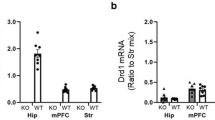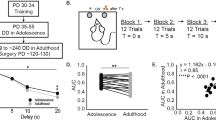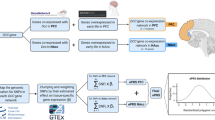Abstract
Impulsivity is an endophenotype found in many psychiatric disorders including substance use disorders, pathological gambling, and attention deficit hyperactivity disorder. Two behavioral features often considered in impulsive behavior are behavioral inhibition (impulsive action) and delayed gratification (impulsive choice). However, the extent to which these behavioral constructs represent distinct facets of behavior with discrete biological bases is unclear. To test the hypothesis that impulsive action and impulsive choice represent statistically independent behavioral constructs in mice, we collected behavioral measures of impulsivity in a single cohort of mice using well-validated operant behavioral paradigms. Mice with manipulation of serotonin 1B receptor (5-HT1BR) expression were included as a model of disordered impulsivity. A factor analysis was used to characterize correlations between the measures of impulsivity and to identify covariates. Using two approaches, we dissociated impulsive action from impulsive choice. First, the absence of 5-HT1BRs caused increased impulsive action, but not impulsive choice. Second, based on an exploratory factor analysis, a two-factor model described the data well, with measures of impulsive action and choice separating into two independent factors. A multiple-indicator multiple-causes analysis showed that 5-HT1BR expression and sex were significant covariates of impulsivity. Males displayed increased impulsivity in both dimensions, whereas 5-HT1BR expression was a predictor of increased impulsive action only. These data support the conclusion that impulsive action and impulsive choice are distinct behavioral phenotypes with dissociable biological influences that can be modeled in mice. Our work may help inform better classification, diagnosis, and treatment of psychiatric disorders, which present with disordered impulsivity.
Similar content being viewed by others
Log in or create a free account to read this content
Gain free access to this article, as well as selected content from this journal and more on nature.com
or
References
Banerjee E, Banerjee D, Chatterjee A, Sinha S, Nandagopal K (2012). Selective maternal inheritance of risk alleles and genetic interaction between serotonin receptor-1B (5-HTR1B) and serotonin transporter (SLC6A4) in ADHD. Psychiatry Res 200: 1083–1085.
Bardo MT, Cain ME, Bylica KE (2006). Effect of amphetamine on response inhibition in rats showing high or low response to novelty. Pharmacol Biochem Behav 85: 98–104.
Bari A, Robbins TW (2013). Inhibition and impulsivity: behavioral and neural basis of response control. Prog Neurobiol 108: 44–79.
Barrus MM, Hosking JG, Zeeb FD, Tremblay M, Winstanley CA (2015). Disadvantageous decision-making on a rodent gambling task is associated with increased motor impulsivity in a population of male rats. J Psychiatry Neurosci 40: 108–117.
Bayless DW, Darling JS, Stout WJ, Daniel JM (2012). Sex differences in attentional processes in adult rats as measured by performance on the 5-choice serial reaction time task. Behav Brain Res 235: 48–54.
Beck RC, Triplett MF (2009). Test-retest reliability of a group-administered paper-pencil measure of delay discounting. Exp Clin Psychopharmacol 17: 345–355.
Berg JM, Latzman RD, Bliwise NG, Lilienfeld SO (2015). Parsing the heterogeneity of impulsivity: a meta-analytic review of the behavioral implications of the UPPS for psychopathology. Psychol Assess 27: 1129–1146.
Blanco C, Potenza MN, Kim SW, Ibanez A, Zaninelli R, Saiz-Ruiz J et al (2009). A pilot study of impulsivity and compulsivity in pathological gambling. Psychiatry Res 167: 161–168.
Broos N, Schmaal L, Wiskerke J, Kostelijk L, Lam T, Stoop N et al (2012). The relationship between impulsive choice and impulsive action: a cross-species translational study. PloS One 7: e36781.
Brunner D, Hen R (1997). Insights into the neurobiology of impulsive behavior from serotonin receptor knockout mice. Ann NY Acad Sci 836: 81–105.
Chamorro J, Bernardi S, Potenza MN, Grant JE, Marsh R, Wang S et al (2012). Impulsivity in the general population: a national study. J Psychiatr Res 46: 994–1001.
Colzato LS, Hertsig G, van den Wildenberg WP, Hommel B (2010). Estrogen modulates inhibitory control in healthy human females: evidence from the stop-signal paradigm. Neuroscience 167: 709–715.
Conner TS, Jensen KP, Tennen H, Furneaux HM, Kranzler HR, Covault J (2010). Functional polymorphisms in the serotonin 1B receptor gene (HTR1B) predict self-reported anger and hostility among young men. Am J Med Genet 153B: 67–78.
Dalley JW, Everitt BJ, Robbins TW (2011). Impulsivity, compulsivity, and top-down cognitive control. Neuron 69: 680–694.
Dalley JW, Fryer TD, Brichard L, Robinson ES, Theobald DE, Laane K et al (2007). Nucleus accumbens D2/3 receptors predict trait impulsivity and cocaine reinforcement. Science 315: 1267–1270.
Dawe S, Loxton NJ (2004). The role of impulsivity in the development of substance use and eating disorders. Neurosci Biobehav Rev 28: 343–351.
Dougherty DM, Mathias CW, Marsh-Richard DM, Furr RM, Nouvion SO, Dawes MA (2009). Distinctions in behavioral impulsivity: implications for substance abuse research. Addict Disord Treat 8: 61–73.
Drew MR, Simpson EH, Kellendonk C, Herzberg WG, Lipatova O, Fairhurst S et al (2007). Transient overexpression of striatal D2 receptors impairs operant motivation and interval timing. J Neurosci 27: 7731–7739.
Eubig PA, Noe TE, Floresco SB, Sable JJ, Schantz SL (2014). Sex differences in response to amphetamine in adult Long-Evans rats performing a delay-discounting task. Pharmacol Biochem Behav 118: 1–9.
Frijda NH (2010). Impulsive action and motivation. Biol Psychol 84: 570–579.
Gizer IR, Ficks C, Waldman ID (2009). Candidate gene studies of ADHD: a meta-analytic review. Hum Genet 126: 51–90.
Guimaraes AP, Schmitz M, Polanczyk GV, Zeni C, Genro J, Roman T et al (2009). Further evidence for the association between attention deficit/hyperactivity disorder and the serotonin receptor 1B gene. J Neural Transm 116: 1675–1680.
Hepler J, Albarracin D, McCulloch KC, Noguchi K (2012). Being active and impulsive: the role of goals for action and inaction in self-control. Motiv Emot 36: 416–424.
Insel TR, Cuthbert BN (2015). Medicine. Brain disorders? Precisely. Science 348: 499–500.
Jensen KP, Covault J, Conner TS, Tennen H, Kranzler HR, Furneaux HM (2009). A common polymorphism in serotonin receptor 1B mRNA moderates regulation by miR-96 and associates with aggressive human behaviors. Mol Psychiatry 14: 381–389.
Jentsch JD, Taylor JR (2003). Sex-related differences in spatial divided attention and motor impulsivity in rats. Behav Neurosci 117: 76–83.
Joreskog KG, Goldberger AS (1975). Estimation of a model with multiple indicators and multiple causes of a single latent variable. J Am Stat Assoc 70: 631–639.
Kessler RC, Berglund P, Demler O, Jin R, Merikangas KR, Walters EE (2005). Lifetime prevalence and age-of-onset distributions of DSM-IV disorders in the National Comorbidity Survey Replication. Arch Gen Psychiatry 62: 593–602.
Kirby KN, Marakovic NN (1996). Delay-discounting probabilistic rewards: rates decrease as amounts increase. Psychon Bull Rev 3: 100–104.
Koot S, van den Bos R, Adriani W, Laviola G (2009). Gender differences in delay-discounting under mild food restriction. Behav Brain Res 200: 134–143.
MacKillop J, Weafer J, C Gray J, Oshri A, Palmer A, de Wit H (2016). The latent structure of impulsivity: impulsive choice, impulsive action, and impulsive personality traits. Psychopharmacology 233: 3361–3370.
Mar AC, Robbins TW (2007). Delay discounting and impulsive choice in the rat. Curr Protoc Neurosci Chapter 8: Unit 8 22.
McDonald J, Schleifer L, Richards JB, de Wit H (2003). Effects of THC on behavioral measures of impulsivity in humans. Neuropsychopharmacology 28: 1356–1365.
Meda SA, Stevens MC, Potenza MN, Pittman B, Gueorguieva R, Andrews MM et al (2009). Investigating the behavioral and self-report constructs of impulsivity domains using principal component analysis. Behav Pharmacol 20: 390–399.
Michaelis BH, Goldberg JF, Davis GP, Singer TM, Garno JL, Wenze SJ (2004). Dimensions of impulsivity and aggression associated with suicide attempts among bipolar patients: a preliminary study. Suicide Life Threat Behav 34: 172–176.
Miyazaki KW, Miyazaki K, Doya K (2012). Activation of dorsal raphe serotonin neurons is necessary for waiting for delayed rewards. J Neurosci 32: 10451–10457.
Miyazaki KW, Miyazaki K, Tanaka KF, Yamanaka A, Takahashi A, Tabuchi S et al (2014). Optogenetic activation of dorsal raphe serotonin neurons enhances patience for future rewards. Curr Biol 24: 2033–2040.
Moeller FG, Barratt ES, Dougherty DM, Schmitz JM, Swann AC (2001). Psychiatric aspects of impulsivity. Am J Psychiatry 158: 1783–1793.
Muthen LK, Muthen BO (1998–2010) Mplus user's guide, 6th edn. Muthen & Muthen: Los Angeles.
National Institutes of Health (2015) NIH-Wide Strategic Plan: Fiscal Years 2016–2020. U.S. Government Printing Office: Washington, DC.
Nautiyal KM, Tanaka KF, Barr MM, Tritschler L, Le Dantec Y, David DJ et al (2015). Distinct circuits underlie the effects of 5-ht1b receptors on aggression and impulsivity. Neuron 86: 813–826.
New AS, Gelernter J, Goodman M, Mitropoulou V, Koenigsberg H, Silverman J et al (2001). Suicide, impulsive aggression, and HTR1B genotype. Biol Psychiatry 50: 62–65.
Newcorn JH, Halperin JM, Jensen PS, Abikoff HB, Arnold LE, Cantwell DP et al (2001). Symptom profiles in children with ADHD: effects of comorbidity and gender. J Am Acad Child Adolesc Psychiatry 40: 137–146.
Pattij T, Broersen LM, Peter S, Olivier B (2004). Impulsive-like behavior in differential-reinforcement-of-low-rate 36 s responding in mice depends on training history. Neurosci Lett 354: 169–171.
Pattij T, Broersen LM, van der Linde J, Groenink L, van der Gugten J, Maes RA et al (2003). Operant learning and differential-reinforcement-of-low-rate 36- s responding in 5-HT1A and 5-HT1B receptor knockout mice. Behav Brain Res 141: 137–145.
Perez-Moreno E, Hernandez-Lloreda MJ, Gallego-Largo TR, Castellanos MA (2015). Impulsive driving: definition and measurement using the i-driving scale (IDS). Span J Psychol 18: E93.
Reynolds B, Ortengren A, Richards JB, de Wit H (2006). Dimensions of impulsive behavior: personality and behavioral measures. Pers Indiv Differ 40: 305–315.
Reynolds B, Penfold RB, Patak M (2008). Dimensions of impulsive behavior in adolescents: laboratory behavioral assessments. Exp Clin Psychopharmacol 16: 124–131.
Robbins TW, Gillan CM, Smith DG, de Wit S, Ersche KD (2012). Neurocognitive endophenotypes of impulsivity and compulsivity: towards dimensional psychiatry. Trends Cogn Sci 16: 81–91.
Rucklidge JJ (2010). Gender differences in attention-deficit/hyperactivity disorder. Psychiatr Clin North Am 33: 357–373.
Saunders B, Farag N, Vincent AS, Collins FL Jr., Sorocco KH, Lovallo WR (2008). Impulsive errors on a Go-NoGo reaction time task: disinhibitory traits in relation to a family history of alcoholism. Alcohol Clin Exp Res 32: 888–894.
St Onge JR, Floresco SB (2009). Dopaminergic modulation of risk-based decision making. Neuropsychopharmacology 34: 681–697.
Story GW, Moutoussis M, Dolan RJ (2015). A computational analysis of aberrant delay discounting in psychiatric disorders. Front Psychol 6: 1948.
Swann AC (2011). Antisocial personality and bipolar disorder: interactions in impulsivity and course of illness. Neuropsychiatry 1: 599–610.
Van den Bergh F, Spronk M, Ferreira L, Bloemarts E, Groenink L, Olivier B et al (2006a). Relationship of delay aversion and response inhibition to extinction learning, aggression, and sexual behaviour. Behav Brain Res 175: 75–81.
van den Bergh FS, Bloemarts E, Groenink L, Olivier B, Oosting RS (2006b). Delay aversion: effects of 7-OH-DPAT, 5-HT1A/1B-receptor stimulation and D-cycloserine. Pharmacol Biochem Behav 85: 736–743.
Wang Q, Chen C, Cai Y, Li S, Zhao X, Zheng L et al (2016). Dissociated neural substrates underlying impulsive choice and impulsive action. NeuroImage 134: 540–549.
Weafer J, Baggott MJ, de Wit H (2013). Test-retest reliability of behavioral measures of impulsive choice, impulsive action, and inattention. Exp Clin Psychopharmacol 21: 475–481.
Weafer J, de Wit H (2014). Sex differences in impulsive action and impulsive choice. Addic Behav 39: 1573–1579.
Winstanley CA (2011). The utility of rat models of impulsivity in developing pharmacotherapies for impulse control disorders. Br J Pharmacol 164: 1301–1321.
Winstanley CA, Dalley JW, Theobald DE, Robbins TW (2003). Global 5-HT depletion attenuates the ability of amphetamine to decrease impulsive choice on a delay-discounting task in rats. Psychopharmacology 170: 320–331.
Winstanley CA, Dalley JW, Theobald DE, Robbins TW (2004). Fractionating impulsivity: contrasting effects of central 5-HT depletion on different measures of impulsive behavior. Neuropsychopharmacology 29: 1331–1343.
Worbe Y, Savulich G, Voon V, Fernandez-Egea E, Robbins TW (2014). Serotonin depletion induces 'waiting impulsivity' on the human four choice serial reaction time task: cross-species translational significance. Neuropsychopharmacology 39: 1519–1526.
Zouk H, McGirr A, Lebel V, Benkelfat C, Rouleau G, Turecki G (2007). The effect of genetic variation of the serotonin 1B receptor gene on impulsive aggressive behavior and suicide. Am J Med Genet B Neuropsychiatr Genet 144B: 996–1002.
Author information
Authors and Affiliations
Corresponding authors
Additional information
Supplementary Information accompanies the paper on the Neuropsychopharmacology website
Supplementary information
Rights and permissions
About this article
Cite this article
Nautiyal, K., Wall, M., Wang, S. et al. Genetic and Modeling Approaches Reveal Distinct Components of Impulsive Behavior. Neuropsychopharmacol 42, 1182–1191 (2017). https://doi.org/10.1038/npp.2016.277
Received:
Revised:
Accepted:
Published:
Issue date:
DOI: https://doi.org/10.1038/npp.2016.277
This article is cited by
-
Serotonin dysfunction in ADHD
Journal of Neurodevelopmental Disorders (2025)
-
Factor analysis of impulsivity in gaming disorder and internet gaming disorder
BMC Psychiatry (2024)
-
Dopamine transporter blockade during adolescence increases adult dopamine function, impulsivity, and aggression
Molecular Psychiatry (2023)
-
Dopamine D2 receptors in nucleus accumbens cholinergic interneurons increase impulsive choice
Neuropsychopharmacology (2023)
-
Dopamine D2 receptors modulate the cholinergic pause and inhibitory learning
Molecular Psychiatry (2022)



